What Is an Air Conditioning Wet Switch/Float Switch & How AC Works
May 6, 2019Air conditioning is a convenience we rely on during the hottest days of summer and — for those of us who live in the Southern United States — for many months of the year. While these useful appliances don’t usually give us any trouble, they are also known to leak, which can cause extensive water damage to your home. In this guide, we’ll teach you how to easily prevent this potentially catastrophic situation with a simple, affordable and easily installable device called an AC float switch or AC safety switch.
How Do Air Conditioning Units Work?
Most air conditioners serve two primary functions — Removing heat for the air and dehumidifying that air. We’ll briefly describe each of these functions below:
1. Cooling
Air conditioners remove heat from the indoor air by making use of a remarkable law in physics. When a liquid turns into a gas — a process known as phase conversion — it absorbs heat. An air conditioning unit takes advantage of this law by forcing certain chemical compounds to evaporate and condense over and over within a coil system.
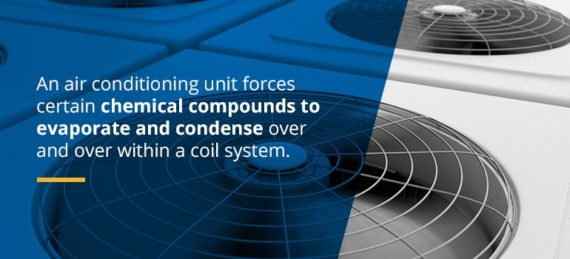
The chemical compounds used in this process are called refrigerants, which have properties that allow them to evaporate at fairly low temperatures. Air conditioning units are equipped with fans that bring in the relatively warm air from the surrounding environment and move it over these coils filled with cold refrigerant, which are known as evaporator coils. Central air conditioners contain entire duct systems that funnel air to and from these coils.
This cooling cycle consists of two main stages:
- The refrigerant is converted to a gas: When warm air flows past these low-pressure, cold evaporator coils, the heat from the air is absorbed by the refrigerant inside the coils as the refrigerant converts from liquid to gas.
- Compression and conversion back to liquid: To continue cooling efficiently, air conditioners must convert these refrigerant gases back into a liquid, which they accomplish with a compressor. This compressor puts the refrigerant gas under high pressure, which creates undesired heat. The heat that results from compressing this gas is then channeled outside the building with the help of another fan and another set of coils known as condenser coils. This causes the refrigerant gas to cool and condense back into a liquid, and then the cycle starts over.
2. Removing Moisture
In addition to removing heat from the indoor air, most air conditioners also serve a second function — removing moisture from the air as it passes through the evaporator coil. As you now know, when warm air is moved over the evaporator coils and the refrigerant liquid inside evaporates, the surrounding air cools. As this air cools, moisture from the air will condense on the outside of the evaporator coils. To get rid of this moisture and provide whole house humidity control, air conditioning equipment contains drain pipes that allows the collected water inside the unit to drain. The water runs down the evaporator coil to a drip pan that temporarily contains the water until it goes down the drain.
What Is a Wet Switch/Float Switch For an HVAC System?
Every once in a while, however, the drain pipes become clogged with debris and dirt, in which case they will no longer be able to effectively remove the water. Considering that a single HVAC unit can collect up to 20 gallons of condensed water a day, it’s not hard to imagine the damage that could occur if the water could not be adequately drained.
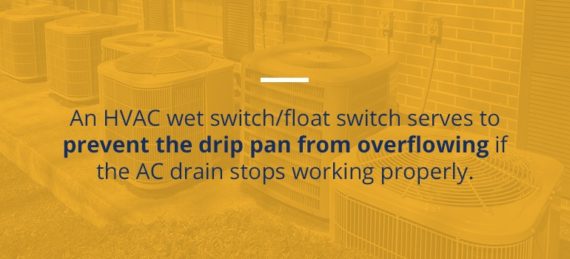
An HVAC wet switch/float switch, also known as a condensate overflow switch, serves to prevent this pan from overflowing if the AC drain stops working properly. The switch is activated when the level of the water in the pan comes above a certain point, causing the switch mechanism to trip/float to rise. When this happens, the switch will then send a message to the AC unit, and it will shut off, stopping the phase conversion and creation of condensation. At this point, a technician can locate and fix the source of the leak before water damage occurs. If your AC float switch keeps tripping or you have an AC float switch failure, call Summers & Zim’s for help.
Where Is the Wet Switch/Float Switch Located?
The location of the wet switch/float switch depends on the orientation of your HVAC equipment. Horizontal units typically have a secondary drip pan, which is found under the unit to prevent excess condensation from doing damage. The wet switch/float switch is attached to this secondary drip pan.
For vertical units or horizontal ones that don’t have a secondary drip pan, you can install a float switch on the PVC drain pipe of the unit, which will become activated if the flow of water becomes obstructed. Some HVAC equipment have a condensate pump installed with it, which the condensation drains into from the AC equipment and is pumped out rather than letting gravity drain it. These pumps also come equipped with a mechanism that resembles a float switch and works in the same way by shutting off the equipment and thereby preventing serious water damage.
Why Do I Need a Wet Switch/Float Switch? What Benefits Does It Provide?
Regardless of the location of your AC, it is critical to have a wet switch/float switch, or, depending on the type of unit, a condensate pump. An AC wet switch/float switch provides the following benefits:
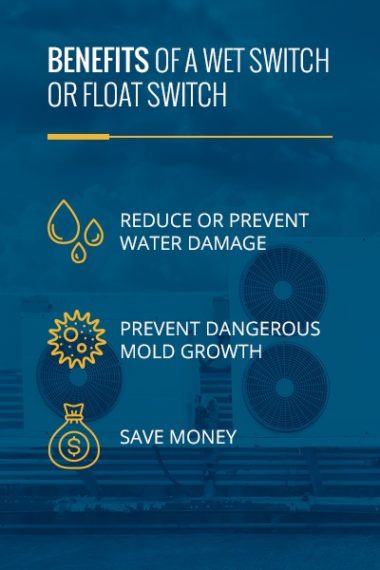
- Reduce or prevent water damage: This safety switch will turn off the compressor, which, as you learned above, is in charge of the AC unit’s condensation process. By installing an AC wet switch/float switch, you’re avoiding what could be a disastrous event.
- Prevent dangerous mold growth: As any homeowner knows, areas that collect moisture are susceptible to mold. If not prevented from leaking moisture can get into unnoticed areas and microbial spores can grow and spread to other nearby areas such as the wall. Mold is not just an eyesore, but can also be foul-smelling and endanger the health of those who breathe it in. If your AC equipment is leaky, mold removal is an issue you might be forced to deal with. Of course, by installing an AC wet switch/float switch, you’ll no longer have to worry about this happening in the first place.
- Save money: Water can cause more damage than you might imagine. A leaky pan or drainage pipe can cause serious structural damage. It may leak into a nearby wall, ruining your AC unit and the wall as well. Installing this simple, affordable switch may save you thousands of dollars worth of damage.
To give you a better idea of how destructive water damage can be, keep in mind that the average cost for drying your property out from a water leak that is “clean,” which means no other damage occurred, is $2,700. The average cost of drying out a home and fixing the damage done to carpeting, drywall and other areas is around $7,500. Costs can be even higher depending on how much water is involved and how extensive the damage is.
While a leak may seem like just an inconvenience, a leak can severely damage a home if not dealt with quickly. In addition to damaging areas like drywall and carpeting, it may also eventually lead to:
- Fire caused by water coming in contact with electrical sources
- Rotting or softening of wood and various other organic materials
- Staining as a result of particles or minerals found in the water that seeps into wood, stone and other porous materials.
Wet Switch or Float Switch for an AC unit?
A common alternative to the float switch is a wet switch, which also detects when condensate water overflows. However, it does this in a different way. Unlike float switches, wet switches are normally placed in a secondary drain pan, which is usually dry. If there is an overflow in the primary pan, it will flow over into the second one. The wet switch, upon detecting this moisture, will turn off the unit to prevent water damage, acting as a safety switch for your AC unit.
Contact Summers & Zim’s for Your Air Conditioning Repair or Installation Needs
If you’re a homeowner in Lancaster, Chester or Delaware Counties in Pennsylvania, you can come to Summers and Zim’s for any of your cooling, heating or plumbing needs. We offer a wide variety of services for your AC system, including AC float switch installation, wet switch installations, and more:
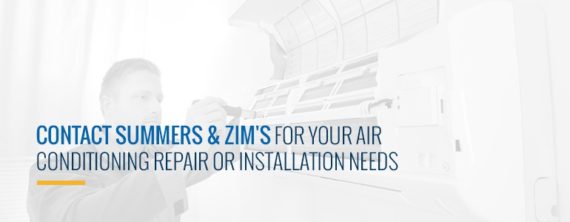
1. System Repair and Replacement
A properly functioning air conditioning system is critical for your comfort and — if it’s extremely hot — your safety as well. Summers and Zim’s will ensure your house stays the reliable refuge you need it to be when the outside temperatures push 100. Don’t hesitate to make an appointment with us for AC maintenance, replacement or repair.
2. Routine Maintenance and Cleaning
We frequently respond to emergency calls to repair central air conditioning problems that the homeowners could have avoided by scheduling a maintenance service earlier on. Maintenance services let professional technicians examine your system and locate any potential problem areas before they cause emergencies.
3. Thermostat and Home Comfort System Service
Although you may give little thought to thermostats or comfort control, if either of these fail, you’ll certainly want them fixed very quickly. At Summers and Zim’s, we offer repair, maintenance and replacement services for your thermostat and home comfort system.
4. Split Ductless Cooling and Heating System Service
Although split ductless systems are not one of the more common heating and cooling methods, they work well in many specific situations, including in homes without ducts, multifamily housing and in smaller home additions and apartments. Although highly dependable, this system will eventually require maintenance, repair or replacement. We have the tools and experience to address any of your split ductless system needs.
5. Air Purification Technology Installation
When creating an ideal home environment, one thing that is often overlooked is overall efficiency, which refers to how well your HVAC equipment can keep the heated or cooled air in your house. The home efficiency testing we perform includes:
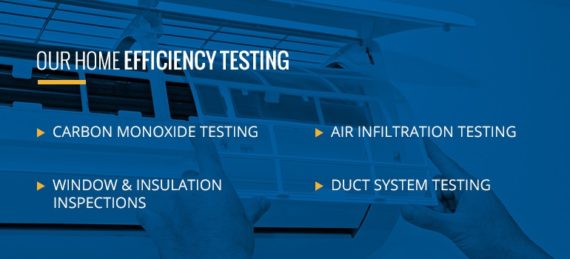
- Carbon monoxide testing: We make sure that the air in your house is safe to breathe and will not endanger the health of your family or your guests.
- Window and insulation inspections: We also inspect your windows and insulation to see if you’re paying more than necessary for your cooling and heating. We search for areas that are not sufficiently insulated, including those tiny, unnoticeable places that are decreasing the energy efficiency of your home and increasing your utility bills.
- Air infiltration testing: We also perform testing for air infiltration that can identify places with leaks, which may include inefficient doors, windows and skylights.
- Duct system testing: The ducts in your home can also significantly decrease the energy efficiency of your home and may make your utility bills soar. Our testing system can determine whether your ducts have leaks and how much air is escaping.
Our 5-Point Guarantee
For over 80 years, we’ve been providing this community with high-quality repairs and preventative maintenance. However, our excellent equipment service isn’t the only reason we’ve been in business so long – we also offer superior customer service by following our 5-Point HVAC Guarantee, which includes the following promises:
- Design Guarantee: When suggesting and designing the perfect system for your house, regardless of whether it’s plumbing, heating or cooling, we guarantee it will work as intended. If the solution that we recommend and design turns out to be unsuitable, we will make any necessary replacements and fixes completely free of charge.
- No-Lemons Guarantee: For most homeowners, a heating, cooling or plumbing system is a big investment, and we believe you should never need to worry about it breaking. For this reason, we offer our customers a No-Lemons Guarantee, which means that, if your equipment fails, we’ll install a new one. If your boiler fails within 10 years, we’ll replace it. And if the water heater fails within the first six years, or your well pump fails in the first five years, we’ll replace those units as well.
- $500 No-Frustration Guarantee: There are few home-owning experiences more infuriating than the failure of a new system, which can leave you without hot water, heating, cooling or other convenience that you depend on for comfort. For this reason, we also offer a generous $500 No-Frustration Guarantee. This means that, if your system breaks down within the first two years and leaves you for 24 hours with no water, heat or hot water due to well pump, boiler or water heater issues, we’ll give you $500 for the inconvenience it has caused.
- Home Protection Guarantee: While most heating system services and plumbing work guarantees include labor and parts, our Home Protection Guarantee offers even more by protecting your entire house. This means all walls, floors, carpeting, door frames and furniture are completely protected. And if we happen to accidentally damage any of your property, we will repair or replace it. Summers and Zim’s technicians use protective covers for their shoes and hall runners where appropriate.
- 100% Money-Back Guarantee: All of our plumbing guarantees and AC and heating service guarantees come with a 100% Money-Back Guarantee. If you are not satisfied with our installation, we’ll remove the equipment and give you 100% of your money back.
Regardless of what service we perform, you can rest assured that we will always abide by this 5-Point HVAC Guarantee. If you need top air conditioner repair, installation or routine maintenance, contact us via our online form or sign up for a membership plan.